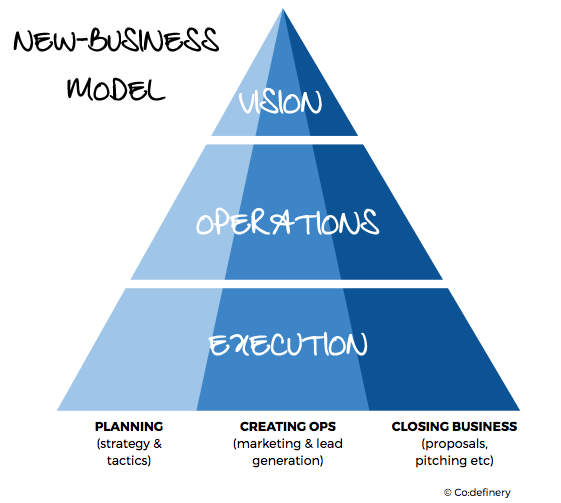Losing at new-business is no fun, but few people appreciate how much having the right model can help you sustain success.

Having highlighted why you need a new-business operating model, a few people asked me to explore some of the options – including pros, cons, headcount and cost.
Defining your New-Business model
To illustrate different models, I split new-business into two sets of three.
Firstly, there are three ‘horizontal’ splits – from C-suite vision at the top, to getting-shit-done worker bees at the bottom. The bit in the middle is where operational decisions are made. It’s your ‘OS’, where process, efficiency and accountability live (or die). I’ll come back to that.
Next, newbiz has three main responsibilities. You can see these at the base of the triangle, moving chronologically through the sales cycle – planning (i.e. strategy and tactics), creating ops (marketing and lead generation) and then closing business (proposals, pitching etc). These are ‘vertical’ splits, in that all levels of seniority contribute.

The other dynamic is frequency, hence the triangle. The senior stuff is at the peak, because you only do it once or twice a year. The high-volume day-to-day legwork is at the base. And again, the middle-ground is where process lives.
Where these horizontal and vertical lines cross in your particular business is what defines your model. How you diagnose this informs roles, responsibilities and budgets, as well as efficiency, accountability and the likelihood of winning. No pressure, then.
Choosing the right model
If you don’t understand these dynamics, then you’re probably reinventing the wheel, failing to learn from mistakes and struggling to win enough. This pisses everyone off, so good people jump ship and you slide towards the expensive failure than is the newbiz panic button.
To help you think about the right set-up, below are four example models, each based on the triangle. They’re not mutually exclusive and they all have way more pros and cons than those listed – but, hey, it’s a start.

Needless to say, there are many other factors at play here. Not least the newbiz talents, capacity and appetite of your C-suite, plus your existing resource, skills and culture around new-business.
I’ve also not mentioned the benefits and risks of outsourcing.
But at least having a little perspective should help you discuss your investment options. Your choice of model informs everything – not least who you hire – and massively improves your chances of ongoing success.
Making winning fun
Ultimately, although focusing your business around a common cause and building deep expertise that clients crave is fundamental, it’s your model that ensures everything works in harmony.
Being in sync is what stops new-business being a slog. It makes the process more enjoyable and that helps you win. And obviously winning is the most fun you can have (clothes on or off).
This virtuous circle is at the heart of creating a genuine new-business culture – where sustained success is built on a sense of purpose, clearly defined roles and everyone trusting one another to perform.
That’s how you win more often, with less effort, and have more fun doing it.